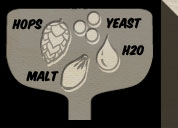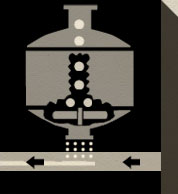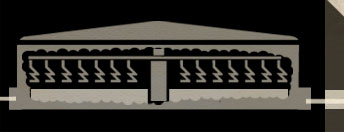
The Process
Actually, why don't we just call it 'craft'? We hate to use words like 'process'. It sounds like what they do to old people in some parallel future where they are our main source of food.






























1. Determining our recipe and sourcing ingredients
When we work on a recipe, particularly with our newer beers, we rarely let the availability, or rather, unavailability, of ingredients get in our way. We enjoy seeking out hard-to-find ingredients such as peach blossoms, we hand-pick and peel ingredients like prickly pear cactus, we smoke our own malts, and we even go to great lengths to source hops that are no longer commercially grown.
2. Milling and Mashing
We crush the malt in our own mill to break apart the kernels and allow access to the starchy enzymes within. The resulting grist is mixed with recycled hot water (recycled because we used it to cool down the previous batch of wort) in a process known as mashing. Mashing breaks down the starch to create fermentable sugars.
3. Lautering and Sparging
After mashing, the resulting sweet liquid is strained from the grains in a process called lautering. We then extract any remaining sugars by running water through the grain bed and adding this sweet wort to the kettle. It should be noted that all manner of desirable ingredients can find their way into our beers beginning as early as the mash tun and at any point from there on.
4. Boiling
We boil the wort in our kettle to concentrate and sterilize it. This is also where the bulk of our hops are added and quite often a whole slew of other ingredients such as herbs or spices.
5. Fermentation
We cool down the sweet wort and then move it into fermentation tanks. It is at this point where we pitch our yeast. The yeast eats the sugars in the beer, the byproducts of which are CO2 and alcohol, and that is the fermentation process. We have cryogenically frozen an individual yeast cell in an undisclosed Colorado lab, and this proprietary yeast strain is used for our flagship beers.
6. Conditioning
Depending upon the type of beer, we now condition it for different lengths of time. Some of our ales are done in two weeks, whereas we might condition, or age, other beers such as our barrel-aged beers for a year or longer. Through our unique relationship with the Peach Street Distillers, we have an endless supply of oak barrels from Colorado's first bourbon.
7. Filtering
Filtering the beer stabilizes the flavor, and gives beer its polished shine and brilliance. Not all beer is filtered. It is at this point where the beer is moved to bright tanks and prepared for packaging.
8. Packaging
At Ska we package certain beers in certain packages for certain reasons. We don't remember what those reasons are, but we're certain it makes sense that our Modus Hoperandi, True Blonde and all flagships are available in 12-ounce cans--whereas some of our specialty and barrel-aged brews are available in 500mL bottles. All of our beers can be found on draft in our tasting room.
When we work on a recipe, particularly with our newer beers, we rarely let the availability, or rather, unavailability, of ingredients get in our way. We enjoy seeking out hard-to-find ingredients such as peach blossoms, we hand-pick and peel ingredients like prickly pear cactus, we smoke our own malts, and we even go to great lengths to source hops that are no longer commercially grown.
We crush the malt in our own mill to break apart the kernels and allow access to the starchy enzymes within. The resulting grist is mixed with recycled hot water (recycled because we used it to cool down the previous batch of wort) in a process known as mashing. Mashing breaks down the starch to create fermentable sugars.
After mashing, the resulting sweet liquid is strained from the grains in a process called lautering. We then extract any remaining sugars by running water through the grain bed and adding this sweet wort to the kettle. It should be noted that all manner of desirable ingredients can find their way into our beers beginning as early as the mash tun and at any point from there on.
We boil the wort in our kettle to concentrate and sterilize it. This is also where the bulk of our hops are added and quite often a whole slew of other ingredients such as herbs or spices.
We cool down the sweet wort and then move it into fermentation tanks. It is at this point where we pitch our yeast. The yeast eats the sugars in the beer, the byproducts of which are CO2 and alcohol, and that is the fermentation process. We have cryogenically frozen an individual yeast cell in an undisclosed Colorado lab, and this proprietary yeast strain is used for our flagship beers.
Depending upon the type of beer, we now condition it for different lengths of time. Some of our ales are done in two weeks, whereas we might condition, or age, other beers such as our barrel-aged beers for a year or longer. Through our unique relationship with the Peach Street Distillers, we have an endless supply of oak barrels from Colorado's first bourbon.
Filtering the beer stabilizes the flavor, and gives beer its polished shine and brilliance. Not all beer is filtered. It is at this point where the beer is moved to bright tanks and prepared for packaging.
At Ska we package certain beers in certain packages for certain reasons. We don't remember what those reasons are, but we're certain it makes sense that our Modus Hoperandi, True Blonde and all flagships are available in 12-ounce cans--whereas some of our specialty and barrel-aged brews are available in 500mL bottles. All of our beers can be found on draft in our tasting room.
1. Determining our recipe and sourcing ingredients:
When we work on a recipe, particularly with our newer beers, we rarely let the availability, or rather, unavailability, of ingredients get in our way. We enjoy seeking out hard-to-find ingredients such as peach blossoms, we hand-pick and peel ingredients like prickly pear cactus, we smoke our own malts, and we even go to great lengths to source hops that are no longer commercially grown.
2. Milling and Mashing:
We crush the malt in our own mill to break apart the kernels and allow access to the starchy enzymes within. The resulting grist is mixed with recycled hot water (recycled because we used it to cool down the previous batch of wort) in a process known as mashing. Mashing breaks down the starch to create fermentable sugars.
3. Lautering and Sparging:
After mashing, the resulting sweet liquid is strained from the grains in a process called lautering. We then extract any remaining sugars by running water through the grain bed and adding this sweet wort to the kettle. It should be noted that all manner of desirable ingredients can find their way into our beers beginning as early as the mash tun and at any point from there on.
4. Boiling:
We boil the wort in our kettle to concentrate and sterilize it. This is also where the bulk of our hops are added and quite often a whole slew of other ingredients such as herbs or spices.
5. Fermentation:
We cool down the sweet wort and then move it into fermentation tanks. It is at this point where we pitch our yeast. The yeast eats the sugars in the beer, the byproducts of which are CO2 and alcohol, and that is the fermentation process. We have cryogenically frozen an individual yeast cell in an undisclosed Colorado lab, and this proprietary yeast strain is used for our flagship beers.
6. Conditioning:
Depending upon the type of beer, we now condition it for different lengths of time. Some of our ales are done in two weeks, whereas we might condition, or age, other beers such as our barrel-aged beers for a year or longer. Through our unique relationship with the Peach Street Distillers, we have an endless supply of oak barrels from Colorado’s first bourbon.
7. Filtering:
Filtering the beer stabilizes the flavor, and gives beer its polished shine and brilliance. Not all beer is filtered. It is at this point where the beer is moved to bright tanks and prepared for packaging.
8. Packaging:
At Ska we package certain beers in certain packages for certain reasons. We don’t remember what those reasons are, but we’re certain it makes sense that our Modus Hoperandi, True Blonde and all flagships are available in 12-ounce cans–whereas some of our specialty and barrel-aged brews are available in 500mL bottles. All of our beers can be found on draft in our tasting room.
